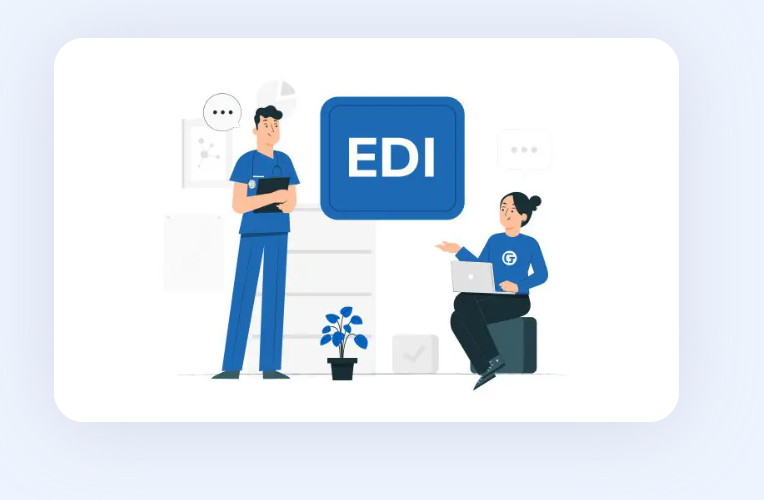Electronic Data Interchange (EDI) transactions have revolutionized the healthcare industry, streamlining processes and enhancing efficiency. In this comprehensive guide, we delve into the intricacies of EDI transactions in healthcare, exploring its significance, implementation, benefits, challenges, and future prospects.
Introduction to EDI Transactions in Healthcare
In today's digital age, the healthcare sector is increasingly adopting EDI transactions to facilitate the electronic exchange of healthcare data. From claims processing to patient record management, EDI plays a pivotal role in optimizing administrative tasks and improving patient care delivery.
Healthcare organizations rely on EDI to transmit various types of information securely and efficiently, including patient demographics, medical claims, eligibility inquiries, remittance advices, and more. By automating these processes, EDI reduces manual intervention, minimizes errors, and accelerates data exchange, thereby enhancing operational efficiency and cost-effectiveness.
The Significance of EDI in Healthcare
EDI transactions offer numerous benefits to healthcare providers, payers, and patients alike. By standardizing data formats and communication protocols, EDI facilitates seamless interoperability among disparate systems and stakeholders. This interoperability is particularly crucial in a complex healthcare ecosystem characterized by multiple entities, such as hospitals, clinics, insurers, pharmacies, and government agencies.
Moreover, EDI enables real-time data exchange, enabling faster claims processing, quicker eligibility verification, and prompt payment adjudication. This not only expedites revenue cycles but also enhances patient satisfaction by reducing administrative delays and improving billing accuracy.
Implementation of EDI in Healthcare Systems
Implementing EDI in healthcare systems involves several key steps, including system integration, data mapping, trading partner setup, testing, and ongoing maintenance. Healthcare organizations must ensure compliance with regulatory requirements, such as HIPAA (Health Insurance Portability and Accountability Act), which mandates the secure and confidential exchange of electronic health information.
Furthermore, selecting the right EDI solution provider is critical to successful implementation. Organizations should evaluate vendors based on factors like scalability, reliability, data security measures, customer support, and cost-effectiveness.
Benefits of EDI Transactions in Healthcare
The adoption of EDI transactions yields a plethora of benefits for healthcare stakeholders. These include:
- Efficiency: EDI streamlines administrative processes, reduces manual errors, and accelerates transaction processing, leading to enhanced operational efficiency.
- Cost Savings: By automating repetitive tasks and minimizing paper-based workflows, EDI helps healthcare organizations save time and resources, resulting in significant cost savings.
- Data Accuracy: EDI ensures the accuracy and integrity of healthcare data by eliminating manual data entry errors and standardizing data formats.
- Compliance: EDI solutions are designed to comply with regulatory requirements, such as HIPAA, ensuring secure and compliant data exchange.
- Enhanced Patient Care: By expediting claims processing and reimbursement, EDI enables healthcare providers to focus more on patient care delivery, thereby improving overall patient experience and outcomes.
Challenges and Considerations
Despite its numerous benefits, implementing and managing EDI in healthcare systems pose certain challenges and considerations. These may include:
- Complexity: EDI implementation requires technical expertise and infrastructure investment, which can be complex and resource-intensive.
- Interoperability Issues: Ensuring seamless interoperability among diverse healthcare systems and trading partners may present interoperability challenges.
- Security Concerns: Protecting sensitive healthcare data from unauthorized access, data breaches, and cybersecurity threats is paramount.
- Regulatory Compliance: Healthcare organizations must adhere to strict regulatory guidelines, such as HIPAA, when handling electronic health information via EDI.
Future Trends and Innovations
Looking ahead, the future of EDI in healthcare appears promising, with ongoing advancements and innovations reshaping the landscape. Key trends and innovations in EDI include:
- Blockchain Technology: Blockchain holds the potential to enhance data security, integrity, and transparency in healthcare transactions by providing a decentralized and immutable ledger.
- AI and Machine Learning: AI-powered algorithms and machine learning models can optimize EDI processes, automate decision-making, and improve data analytics capabilities.
- Interoperability Standards: Continued efforts to develop and standardize interoperability protocols will facilitate seamless data exchange and collaboration across healthcare networks.
FAQs (Frequently Asked Questions)
What are EDI transactions in healthcare? EDI transactions refer to the electronic exchange of healthcare data between various stakeholders, such as healthcare providers, insurers, pharmacies, and government agencies. These transactions include claims processing, eligibility verification, remittance advices, and more.
How does EDI benefit healthcare organizations? EDI offers numerous benefits to healthcare organizations, including improved operational efficiency, cost savings, enhanced data accuracy, regulatory compliance, and better patient care delivery.
What challenges are associated with implementing EDI in healthcare systems? Implementing EDI in healthcare systems may pose challenges such as complexity, interoperability issues, security concerns, and regulatory compliance requirements.
What are some future trends in EDI for healthcare? Future trends in EDI for healthcare include the adoption of blockchain technology, leveraging AI and machine learning, and ongoing efforts to standardize interoperability protocols.
How can healthcare organizations ensure data security in EDI transactions? Healthcare organizations can ensure data security in EDI transactions by implementing robust encryption measures, access controls, authentication mechanisms, and regular security audits.
What role does regulatory compliance play in EDI transactions in healthcare? Regulatory compliance, particularly with laws such as HIPAA, is essential in EDI transactions to safeguard patient privacy, ensure data security, and maintain trust in healthcare systems.
Conclusion
In conclusion, EDI transactions have emerged as a cornerstone of modern healthcare, facilitating the electronic exchange of vital healthcare information. By streamlining processes, improving efficiency, and enhancing data accuracy, EDI plays a pivotal role in driving operational excellence and improving patient care delivery. While challenges and considerations exist, ongoing advancements and innovations hold the promise of a more connected, interoperable, and efficient healthcare ecosystem powered by EDI.
